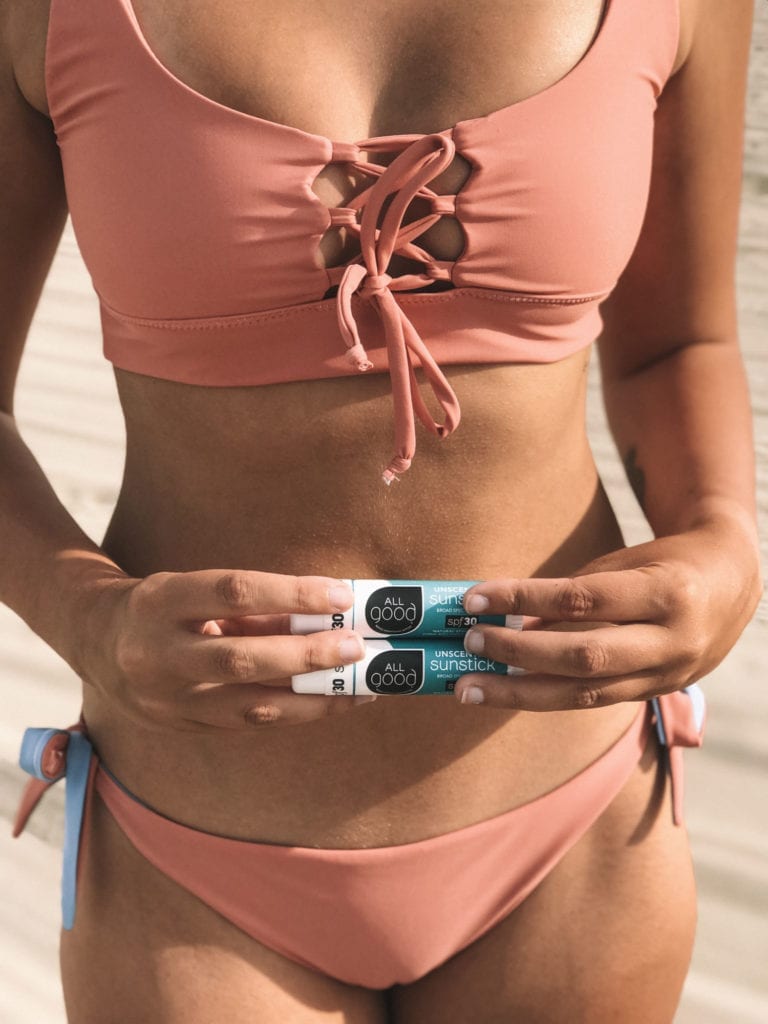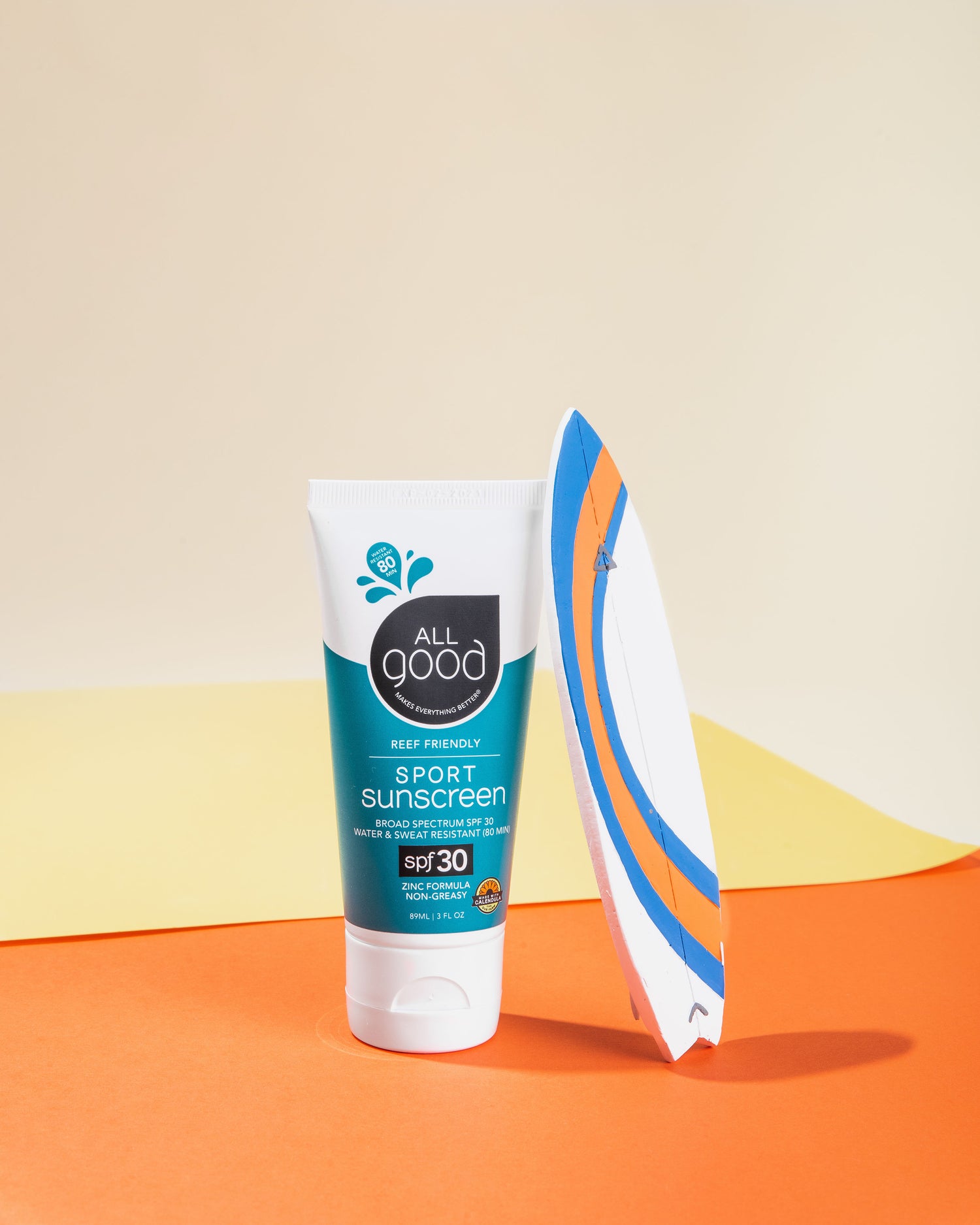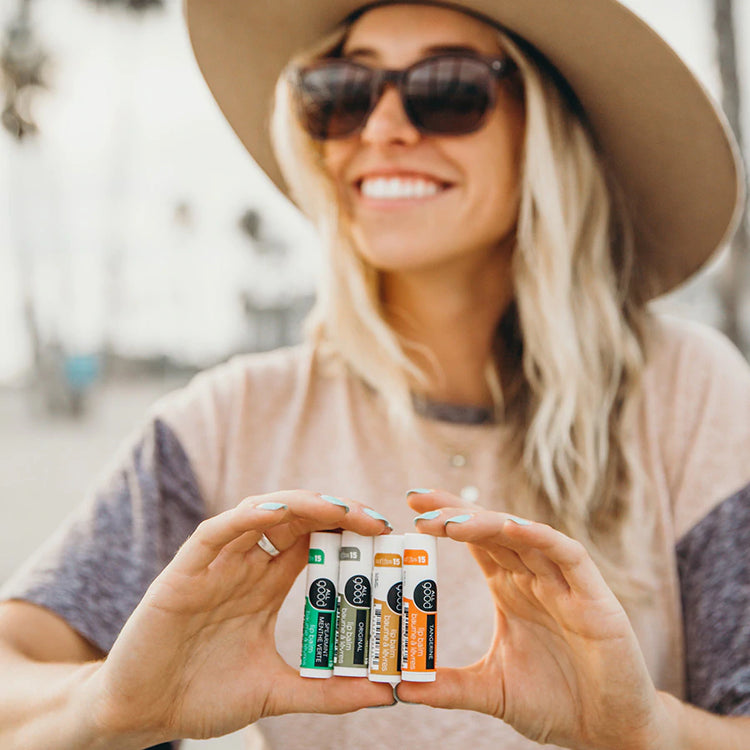
Body and Reef Friendly Sunscreen
There are loads of toxic chemicals in conventional sunscreen that harm coral reefs in many different ways. First, harmful chemicals in conventional sunscreen enter the ocean when vacationers, swimmers, surfers, etc. use a toxic sunscreen on their body and get in the ocean. Even if you don’t go directly in the ocean, sunscreen lotion will eventually be washed off your body in the shower and end up back to the ocean. These chemicals are very tenacious.
And if you thought you were very different than coral reefs, think again. After you lather yourself head to toe, your skin begins to absorb chemicals from sunscreen. These chemicals can be measured in the body through blood, breast milk, and urine samples (aka: one crazy saturday night). Even the FDA has found that some of these toxic ingredients enter the bloodstream at levels far beyond what the recommended FDA-established threshold. Yet another reason mineral sunscreens are the better choice for you and for the coral reefs.
This concise list of “bad” and “good” ingredients will help you answer: “What criteria do I need to look out for before purchasing my next sunscreen?”
The Bad, Not Safe List
The compounds in these ingredients, preservatives, and additives are toxic to humans and coral reefs. If any one of these ingredients is listed in a sunscreen, it is NOT considered reef safe, reef friendly, or – you guessed it – safe for you.
1. "The Awful Eight"
• Oxybenzone
• Octinoxate
• Octocrylene
• PABA (Aminobenzoic Acid• Enzacamene
• Octisalate
• Homosalate
• Avobenzone
2. Preservatives & Additives
• Methyl Paraben
• Ethyl Paraben
• Propyl Paraben
• Butyl Paraben
• Benzyl Paraben
• Phthalates
• Triclosan Microbeads (plastic)
• Phenoxyethanol
Oxybenzone deserves a special call out for its particularly horrible damage on coral reefs and humans; you can learn more about public enemy number one here.

The Good, Safe List
The good list is short and sweet:
• Non-nano Zinc oxide
• Non-nano Titanium dioxide
Look for unscented, oxybenzone-free, mineral-based sunscreens that use raw elements instead of synthetic ones and exclude the “bad” ingredients and preservatives that disrupt human hormone function or bleach coral. The only way to really know is to read the labels and look for the toxic ingredients.
Our sunscreens offer the same broad spectrum protection (from both UVA and UVB rays) as conventional sunscreens, without relying on toxic ingredients. We do this by avoiding the “Awful Eight” and using these two main ingredients instead:
Zinc Oxide
Zinc oxide is derived from the mineral zinc. It’s able to block UV (especially UVA) rays just as effectively as any of the Awful Eight. Because it’s mineral-based, it won’t seep into your skin to risk your health, is less harmful to coral, and is not known to cause coral bleaching. With that said, avoid sunscreens with zinc oxide that are labeled as “clear zinc” or “transparent”. They’re likely to use zinc oxide nanoparticles (very very small-size particles of zinc oxide) to achieve this transparency, which scientists have found toxic to sea creatures and coral. So look for non-nano zinc sunscreens.
Titanium Dioxide
ike zinc oxide, sunscreens that contain titanium dioxide are mineral-based. Titanium dioxide is a great alternative to oxybenzone and octinoxate. It provides effective protection against UV rays (especially UVB). Sunscreens created with both zinc oxide and titanium dioxide can offer broad spectrum protection against both UVA and UVB rays. However, make sure that the titanium dioxide in your sunscreen is non-nano. Like zinc oxide, titanium dioxide nanoparticles can clog coral when ingested and lead to coral bleaching.
How does sunscreen affect coral reefs?
Coral reefs are more than just a pretty face. They support an incredible underwater ecosystem, cover less than 1% of the ocean floor but support more than 25% of all marine life, and their very existence defends our coastlines against the worst effects of storms and hurricanes. Nature knows what’s up. But climate change and human impact (like overfishing and chemical runoff) have accelerated coral bleaching and mutation, ultimately leading to coral death.
Some of that chemical runoff comes from the 14,000 tons of sunscreen products that reach and damage our coral reefs each year. That just doesn’t sit well with us. In 2016, our founder, Caroline, got hip to the issue of coral bleaching from toxic sunscreen runoff. She got to work searching for reef friendly alternatives and found there was a huge need for more credible, non-toxic suncare products. To help preserve the coral that’s still alive, it’s critical that we use sunscreen that meets reef friendly criteria.
Once in the water, the nano-particals in sunscreen chemicals latch onto Coral and clog the pores (yes, coral has pores). This prevents the coral from getting the sunlight and nutrients it needs, which can lead to coral bleaching and eventual death.
Several studies have shown that the most common chemical, oxybenzone, actually damages the DNA of young coral reefs and disrupts their normal growth and development. This inhibits coral’s ability to reproduce healthily and causes physical deformities that make them even more susceptible to coral bleaching. Chemical-based sunscreens have been found to cause viral infection and starvation in corals, and can be equally toxic to other marine wildlife species, like fish (say goodbye to Nemo, kids).
Reef Friendly Sunscreen Criteria
What’s good for the reefs is good for the gander. Most of the chemicals that are harmful to marine life are just as damaging to human health. Reef-friendly means environmentally safe, nontoxic, kid-friendly, and human safe. It means safe for people and safe for critical marine organisms like the coral reef. Reef friendly criteria is pretty simple: A sunscreen cannot contain any of the ingredients from “The Awful Eight.” No matter how many “good” ingredients are listed, if even ONE “bad” ingredient is listed it’s a toxic, non reef friendly sunscreen.
A word to the wise: If you read something is “natural sunscreen” or “dermatologist-approved,” that doesn’t necessarily mean it’s reef-friendly. Some brands tout the use of exotic, super-food ingredients (like green tea or beeswax) and claim to be “mineral-based sunscreens,” but there could be a lot of harmful ingredients mixed in that make it very unhealthy for reefs. This is what we call “greenwashing” – companies that claim to be eco-friendly, but when you scratch below the surface you find the science doesn’t back up the claims. And just so we’re all clear, WE BELIEVE IN SCIENCE! (Alternative facts can go die a fiery death.)






